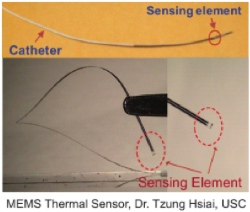Researchers at the University of Southern California have developed a new method to detect pre-atherosclerotic lesions. When deployed by an angiogram catheter, a micro-electro-mechanical system (MEMS) thermal sensor can detect the early onset of atherosclerosis.
Shear stress is the frictional force, which acts on the vessel walls due to the flow of blood. Combination of oxidative stress and inflammatory reaction causes atherosclerosis. The flow is disturbed in areas prone to atherosclerosis.
 MEMS Thermal Sensor
MEMS Thermal Sensor
The USC team developed a MEMS by depositing platinum and titanium on a flexible polymer membrane. Sensing elements were formed by patterning the deposits. The scientists used an angiogram catheter to deploy the sensor into the abdominal and aortic arteries of rabbits, which were on a high-cholesterol and high-fat diet.
The Associate Professor of Biomedical Engineering and Cardiology at USC, Dr Tzung Hsiai stated that a convective heat transfer detects the differences in output voltage signals in the normal arterial regions, which helps in determining the pre-atherosclerotic regions of the arteries. In the blood vessel with the atherosclerotic plaque, the sensor detected a high voltage upstream and a low voltage downstream.
With the study, it was concluded that it was possible to detect pre-atherosclerotic regions in spite of a lack of clinical signs. The scientists verified the results by dissecting the aortas and integrating fluoroscopic images and mathematical simulations.
Once the atherosclerotic lesion is identified, doctors can determine if the lesion is a stable or a vulnerable plaque that could rupture and treat it accordingly. A sensitive and minimally invasive method, the technology can be applied in diagnostic angiograms. It can also eliminate unwanted procedures thereby reducing health costs.
The study has been published in the Annals of Biomedical Engineering.